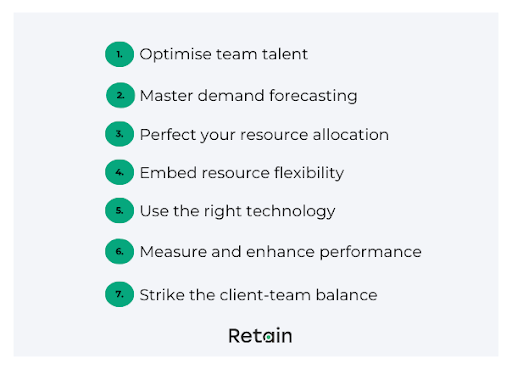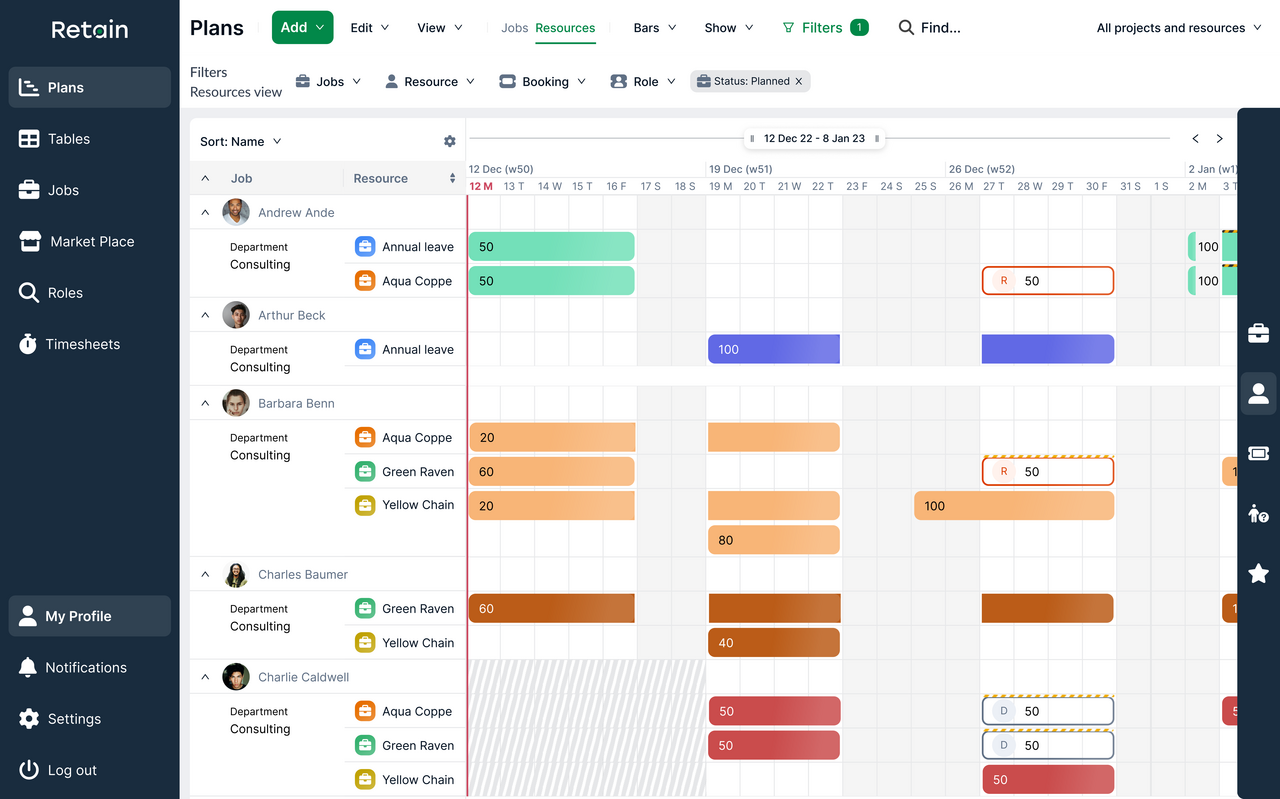In consultancy, getting resource management right is essential. When you match the right people to the right tasks at the right time, you set your business up for success. Fail, and you risk missed deadlines, strained client relationships, and burnout.
But consultancy firms face tough challenges when it comes to managing resources. Projects often overlap, and the demand for specialist skills can change rapidly. Using outdated tools like spreadsheets can lead to inefficiencies, with some team members overbooked while others wait for work. Add in the rise of hybrid and remote work, and it’s clear that the old methods no longer cut it.
That’s quite a lot to contend with. To help you improve managing consulting resources, we’re going to share the 7 ways market leaders optimise resources.

Managing consulting resources tip #1: Optimise team talent
Managing consulting resources starts with a deep understanding of your team. Knowing your people's skills, expertise, and specialist skills is crucial for assigning the right individuals to the right projects.
Assessing skills and competencies means knowing each team member's unique strengths to ensure they're making the biggest impact possible. Modern resource management approaches provide a real-time, centralised view of your talent pool, replacing outdated methods and enabling data-driven decision-making.
Identifying specialist skills and expertise is key. Advanced tools can offer instant insights into your team's capabilities, while AI-powered systems can suggest potential matches based on similar experiences. This data-driven approach keeps projects on track and keeps top talent engaged and challenged.
What’s more, maintaining an up-to-date resource database is key to smooth operations. With a clear, real-time view of your resource pool, including skills, availability, and project history, you can engage in agile planning, scheduling, and adjustments.
Managing consulting resources tip #2: Master demand forecasting
Balancing immediate demands with long-term goals is key when managing consulting resources. Anticipating project needs begins with real-time visibility across your organisation.
To make this quick and easy, implement systems that provide clear, up-to-date views of team assignments and availability. This live overview enables you to quickly adapt to changes and seize new opportunities.
You can then leverage historical data and market trends to enhance your forecasting capabilities. By analysing past project patterns, skill requirements, and resource allocation, you can make more accurate predictions. To ensure smooth operations, use tools like Retain that identify both fully booked team members and those with capacity.
Balancing short-term and long-term resource requirements is challenging, especially when projects shift unexpectedly. Here, we’d recommend developing the capability to create and analyse "what-if" scenarios, allowing you to plan for various outcomes effortlessly. This prepares you to adjust to expanding projects or new requests without overwhelming your team. Plus, custom workflows provide the flexibility to manage both immediate needs and future objectives.
Managing consulting resources tip #3: Perfect your resource allocation
When it comes to managing consulting resources, aligning skills with project needs and balancing workloads ensures operations run smoother. Projects progress efficiently, clients remain satisfied, and your team stays engaged without feeling overwhelmed.
But don't fall into the trap of assuming that overall capacity is the only metric that matters. Focusing solely on this can lead to some team members being overworked while others are underutilised. Strive for clear insights into utilisation levels across your team, balancing workloads to prevent burnout. Remember, the goal isn't to squeeze every last minute out of your resources—it's about building in flexibility to handle unexpected changes smoothly.
Balancing workloads across teams is essential to prevent bottlenecks and ensure consistent delivery. Be vigilant about situations where some teams might be overloaded while others are idle. Develop processes to easily identify available team members who can step in to support busier colleagues, keeping workloads balanced and ensuring no one carries an excessive burden.
Managing consulting resources tip #4: Embed resource flexibility
A flexible approach to managing consulting resources ensures projects continue to run smoothly despite rapid changes. By focusing on training and building a reliable outsourcing network you can adapt swiftly to new challenges and opportunities. Let’s delve into this a little more…
Cross-training and skill development 🔀
This approach is about creating a versatile workforce capable of stepping in where needed, even outside their primary expertise. This versatility prevents bottlenecks and keeps work flowing when key team members are unavailable. Regularly assess your team's skills and availability to identify opportunities for cross-training and development.
Build a network of trusted contractors 🤝
Even with a well-prepared in-house team, there will be times when additional expertise or manpower is needed, especially during peak periods or for tasks that require specialist skills. A reliable contractor network allows you to scale up quickly without lengthy hiring processes, ensuring you always have access to the right skills at the right time.
Implementing agile resource management practices ⏩
This keeps your team responsive and ready for change. Aim for a healthy utilisation rate—typically between 70% and 80%—to ensure your team has the capacity to adapt without risking burnout. Regular reviews and updates to resource plans are essential agile practices.
Managing consulting resources tip #5: Use the right technology
The era of managing resources through disconnected spreadsheets is over. Modern resource planning and scheduling software completely changes team management, enhancing organisation, decision-making, and project execution.
When all essential information is consolidated in one place, you can efficiently assign tasks, monitor workloads, and adjust schedules. It eliminates guesswork and last-minute scrambling, providing you with greater control and insight.
When selecting resource management software, consider these key features:
✅AI-powered suitability matching: This feature rapidly identifies the right people for project needs based on skills and experience.
✅Real-time data and analytics: Up-to-the-minute insights into resource availability, team performance, and project timelines support informed decision-making.
✅Seamless integrations: Look for software that integrates with your existing tools to create a unified workflow.
✅Scalability: Choose a solution that can grow with your business, whether you're managing a small team or a global workforce.
Take a tour of Retain to see for yourself here.

Managing consulting resources tip #6: Measure and enhance performance
Effective resource management extends beyond task assignment. To maintain project momentum and optimise team performance, it's crucial to measure resource utilisation and act on the results. This means focusing on key metrics, conducting regular reviews, and committing to continuous improvement.
Key Performance Indicators (KPIs) for resource management provide a clear view of resource utilisation effectiveness. Essential metrics include:
📏Utilisation rates
📏Capacity planning accuracy
📏Project progress
Track these KPIs in real-time to gain actionable insights. Implement tools that allow you to generate custom reports and visualise data through intuitive dashboards. This enables you to identify trends, spot bottlenecks, and address issues proactively before they escalate.
However, metrics alone are insufficient. Regular performance reviews and feedback loops are vital to ensure your resource management strategies remain effective. Consistently evaluate your team's performance at both project and business-wide levels. This allows you to:
- Fine-tune resource allocation
- Redistribute workloads as needed
- Ensure appropriate support for each project
Lastly, consider implementing "bench reports" to easily identify available team members and those who might benefit from additional opportunities. This approach helps maintain a balanced and motivated team.
Managing consulting resources tip #7: Strike the client-team balance
Build long-term client relationships through consistent delivery. Clients value reliability, and delivering excellent results over time strengthens trust. By prioritising both resource wellbeing and client satisfaction, you create a win-win situation: your team stays motivated, and clients benefit from high-quality, timely work.
Here are just a handful of ideas to maintain balance:
Regular check-ins with clients and team members
Clear communication of project scopes and deadlines
Flexibility in resource allocation
Encouraging breaks to prevent burnout
- Recognising team efforts
By focusing on both client needs and team wellbeing, you can deliver outstanding results sustainably, ensuring long-term success for your consultancy.
Making resource management work for you
From matching the right people to the right projects to ensuring your team stays flexible and well-balanced, the best practices we've covered here are all about creating a system that works for both your business and your people.
By focusing on optimising resource allocation, enhancing flexibility, and leveraging the right resource management technology, you can prevent burnout and improve project outcomes and client satisfaction.
Ultimately, adopting modern resource planning and scheduling tools gives you a competitive edge. It allows you to make smarter decisions, balance workloads more effectively, and ensure both your clients and team are happy.
💡For more ideas on how to implement best practice resource management, join our LinkedIn community and newsletter.


